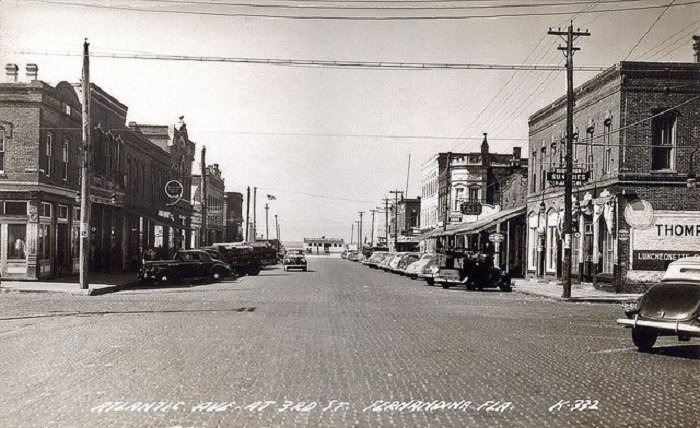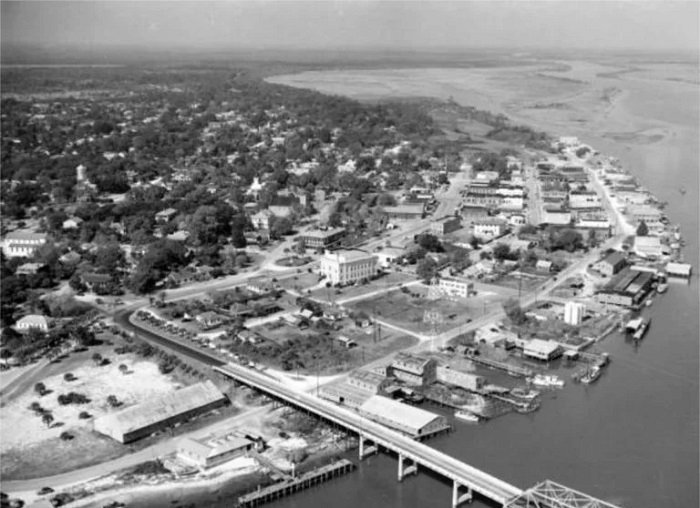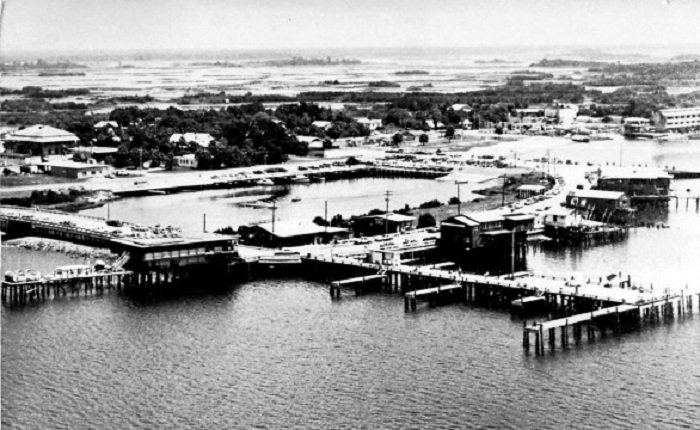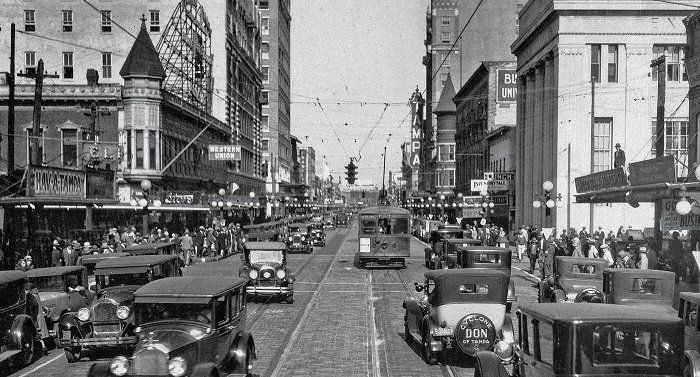Florida is a state with a rich and diverse history that dates back thousands of years. From the indigenous tribes that once roamed the land, to the Spanish explorers who first arrived in the 16th century, Florida has a long and fascinating history. Many of Florida’s cities have been around for centuries and serve as a testament to the state’s past. In this article, we will explore the top 15 oldest cities in Florida, their founding dates, and their historical significance. Whether you are a history buff or just curious about the state’s past, these cities offer a glimpse into Florida’s rich heritage.
1. Pensacola
Pensacola is a historic city located in the western part of the Florida Panhandle. Founded in 1559 by Spanish explorer Tristán de Luna y Arellano, Pensacola is the second-oldest city in Florida. The city was established as a Spanish colony and served as a strategic military outpost for the Spanish Empire. Throughout its history, Pensacola has been ruled by the Spanish, French, British, and American governments, each leaving its own unique imprint on the city’s culture and architecture.
See also: Top 10 Oldest Cities in Texas

Today, Pensacola is known for its stunning beaches, charming historic district, and vibrant arts scene. The city is home to several museums and galleries, including the Pensacola Museum of Art, the National Naval Aviation Museum, and the Pensacola Lighthouse and Museum. Pensacola is also home to a thriving downtown area, with a variety of shops, restaurants, and nightlife options.
Despite being hit by multiple hurricanes throughout its history, Pensacola has managed to preserve much of its historic charm. Visitors can take a stroll through the city’s historic district, which features beautiful examples of Spanish, French, and British architecture. Overall, Pensacola is a fascinating city with a rich and diverse history, making it a must-visit destination for anyone interested in Florida’s past and present.
2. Fernandina Beach
Fernandina Beach, located on Amelia Island in Northeast Florida, was founded in 1562 by the French explorer Jean Ribault. However, it was abandoned soon after due to conflicts with the local Timucuan Indians. In 1573, the Spanish established a mission on the island, and Fernandina Beach became a strategic location for both Spanish and British colonization efforts in the region. The town was named after King Ferdinand VII of Spain and served as a port for the export of timber, cotton, and other goods.

During the American Civil War, Fernandina Beach was occupied by Union forces and used as a base for their operations in the region. After the war, the town experienced a period of growth and development, becoming a popular tourist destination with the opening of luxurious resorts and hotels.
Today, Fernandina Beach is a charming coastal town that retains much of its historic character, with many of its buildings dating back to the 19th century. It is home to a vibrant arts scene, as well as a number of restaurants, shops, and galleries. The town is also known for its beautiful beaches and outdoor activities, such as fishing, boating, and kayaking.
3. St. Augustine
St. Augustine is a city that is steeped in history, culture, and charm. It was founded by Spanish explorer Pedro Menéndez de Avilés in 1565, making it the oldest continuously inhabited city in the United States. The city’s rich heritage can be seen in its unique blend of Spanish Colonial, British Colonial, and Moorish Revival architecture, and in the many historical landmarks that dot its streets.
One of the most famous landmarks in St. Augustine is the Castillo de San Marcos, which is the oldest masonry fort in the continental United States. This fort has been standing for over 330 years and has survived numerous attacks, including pirate raids and invasions by the British. It is now a National Monument that is open to the public, and visitors can explore its many rooms and learn about its fascinating history.

St. Augustine’s historic district is also a major draw for visitors, with its cobblestone streets, quaint shops, and charming cafes. The city is home to many other important historical landmarks, such as the Fountain of Youth Archaeological Park, the St. Augustine Lighthouse & Maritime Museum, and the Oldest Wooden Schoolhouse in the United States.
Overall, St. Augustine is a city that has managed to preserve its unique cultural heritage while also embracing modern amenities and attractions. Whether you are a history buff or just looking for a charming getaway, St. Augustine is definitely worth a visit.
4. Jacksonville
Jacksonville, located in Northeast Florida, was founded in 1791 and was named after Andrew Jackson, who would later become the seventh President of the United States. The city has a rich history, with a variety of industries contributing to its growth and development over the years.
During the Civil War, Jacksonville was an important port for the Confederacy and was occupied by Union forces in 1862. After the war, the city began to rebuild and expand, with new industries such as lumber and tourism emerging as major drivers of the local economy.
You may also like: Top 15 Oldest Cities in California

Today, Jacksonville is one of Florida’s largest cities and serves as a hub for transportation, finance, and healthcare in the region. The city is home to several colleges and universities, including Jacksonville University and the University of North Florida, and has a thriving arts and culture scene, with numerous museums, galleries, and performance venues.
Jacksonville also boasts a variety of outdoor recreation opportunities, with over 80,000 acres of parks, preserves, and waterways throughout the city and surrounding areas. Some of the most popular attractions include the Jacksonville Zoo and Gardens, the Cummer Museum of Art and Gardens, and the St. Johns Riverwalk.
Overall, Jacksonville’s rich history, diverse economy, and abundance of recreational opportunities make it a popular destination for visitors and a great place to call home for residents.
5. Key West
Key West, the southernmost city in the continental United States, was founded in 1822 and played an important role in the history of Florida and the nation. During the Civil War, Key West was a major naval base and was used to blockade Confederate ships and supply lines. The city also served as a haven for Cuban exiles during their fight for independence from Spain in the late 19th century.
In the early 20th century, Key West became a popular destination for writers and artists, including Ernest Hemingway, who lived there for many years. Hemingway’s former home in Key West is now a museum and a popular tourist attraction. Today, Key West is known for its laid-back lifestyle, beautiful beaches, and colorful culture.

One of the most famous events in Key West is the annual Fantasy Fest, a 10-day celebration in October that features parades, parties, and costume contests. The city is also home to several historic landmarks, including the Ernest Hemingway Home and Museum, the Key West Lighthouse, and the southernmost point marker, which marks the southernmost point in the continental United States.
6. Apalachicola
Apalachicola is a small city located in the panhandle of Florida, founded in 1831. It was once a bustling center for the cotton trade during the 19th century, and many of its historic buildings from that era still stand today. The city’s downtown area is listed on the National Register of Historic Places and features restored storefronts, Victorian-era homes, and a vibrant arts community. The city’s location at the mouth of the Apalachicola River also made it an important port for shipping goods and supplies throughout the region.
Today, Apalachicola is known for its thriving seafood industry and is considered the oyster capital of Florida. The city is home to several seafood markets and restaurants that serve up fresh catches daily. The Apalachicola National Estuarine Research Reserve is also located in the area and provides visitors with a chance to learn about the unique ecosystem of Apalachicola Bay.

In addition to its rich history and thriving seafood industry, Apalachicola is also known for its natural beauty. The nearby St. George Island State Park offers miles of pristine beaches and hiking trails, while the Apalachicola National Forest provides opportunities for camping, fishing, and birdwatching. With its charming downtown, picturesque setting, and abundance of outdoor activities, Apalachicola is a hidden gem in Florida’s panhandle.
7. Cedar Key
Cedar Key, located on the Gulf Coast of Florida, was founded in 1842 and quickly became an important center for the shipping industry. Cedar Key’s strategic location near the mouth of the Suwannee River made it a key port for transporting goods such as lumber, cotton, and turpentine from the interior of Florida to other parts of the country. In the late 1800s, the town’s economy shifted to the sponge industry. Sponge divers would venture out into the Gulf of Mexico and bring back sponges to be sold in Cedar Key and other markets. Cedar Key was known as the “Sponge Capital of the World” during this time, and sponge diving remains an important industry in the town today.
See also: Top 10 oldest cities of Georgia

Cedar Key has also played a role in Florida’s history as a center for the fishing industry. The town’s location on the Gulf Coast and its many nearby islands and bays provide abundant fishing opportunities. Today, Cedar Key is a charming coastal town that attracts visitors with its small-town feel, historic downtown, and natural beauty.
8. Tampa
Tampa, located on the west coast of Florida, was founded in 1849 and has since grown into one of the state’s largest cities. It was originally settled by Native American tribes, including the Tocobaga, but was later claimed by the Spanish and served as a military outpost during the Seminole Wars. In the late 1800s, Tampa’s strategic location as a major port and rail hub led to its rapid growth, with industries like cigar manufacturing and phosphate mining fueling its economy. The discovery of phosphate in the surrounding area led to a boom in the late 1800s, making Tampa one of the wealthiest cities in Florida at the time. The arrival of the railroad in the 1880s further accelerated Tampa’s growth, as it made transportation of goods and people faster and more efficient.

Today, Tampa is a thriving city with a diverse economy that includes industries like finance, healthcare, and tourism. It is also home to several major sports teams, including the NFL’s Tampa Bay Buccaneers and the NHL’s Tampa Bay Lightning. Tampa’s rich history is still visible throughout the city, from historic buildings like the Tampa Bay Hotel to the Ybor City neighborhood, which was once the center of the cigar industry.
9. Melbourne
Melbourne, Florida, was founded in 1867 and named after the Australian city of the same name. The city was originally settled by freed slaves and Civil War veterans and grew quickly thanks to the citrus industry. In the late 1800s and early 1900s, Melbourne became a major center for citrus production and was home to several packinghouses and groves.
In addition to citrus, Melbourne also had a thriving railroad industry, as it was located on the Florida East Coast Railway. The railway allowed for the transport of goods and people throughout Florida and beyond, contributing to the city’s growth and development.

During World War II, Melbourne became an important center for military activity, as it was home to several military bases and training facilities. After the war, much former military personnel chose to settle in Melbourne, leading to a population boom in the post-war years.
Today, Melbourne is a vibrant city with a strong economy based on technology, aerospace, and tourism. The city is home to several high-tech companies, including Harris Corporation and Northrop Grumman, and is located near the Kennedy Space Center and other aerospace facilities. Additionally, Melbourne’s beautiful beaches and sunny weather make it a popular destination for tourists and retirees.
10. Daytona Beach
Daytona Beach, located on the east coast of Florida, was founded in 1870 by Matthias Day, a wealthy tycoon from Mansfield, Ohio. Initially, the city was known for its shipping and farming industries, but it quickly became a popular destination for tourists seeking a warm and sunny getaway. In 1902, the first automobile race was held on the beach, and in 1936, the Daytona International Speedway was constructed, which helped solidify the city’s reputation as a center for motorsports.
In addition to auto racing, Daytona Beach is also known for its beautiful beaches. The city’s wide, sandy shores attract thousands of visitors each year, who come to swim, sunbathe, and surf. Other popular attractions in the area include the Daytona Beach Boardwalk and Pier, the Daytona Lagoon water park, and the Marine Science Center.

Daytona Beach has also played an important role in American history. During World War II, the city served as a training ground for the US Army Air Corps, and the nearby Embry-Riddle Aeronautical University remains one of the top flight schools in the country. Today, Daytona Beach continues to be a popular destination for tourists and is a thriving center for business, education, and culture in the state of Florida.
11. Tarpon Springs
Tarpon Springs is a picturesque city located in Pinellas County, Florida. It was founded in the late 19th century by a group of wealthy businessmen who saw the potential for the area’s sponge industry. They brought in Greek sponge divers to work in the waters off the coast of Tarpon Springs, and soon the town became known as the “Sponge Capital of the World.”
Today, Tarpon Springs is still famous for its sponge industry and remains a hub for Greek culture and cuisine. Visitors can take a boat tour to watch sponge divers at work, visit the Sponge Docks and browse the many gift shops, restaurants, and bakeries that line the streets.
See also: 15 oldest Cities & Towns in Ohio

In addition to its Greek heritage, Tarpon Springs also has a rich history that includes the arrival of the railroad in the late 19th century and the devastating impact of the Great Depression in the 1930s. Despite these challenges, the town has persevered and today is a thriving community with a unique identity and rich cultural heritage.
Whether you come to Tarpon Springs for the history, the food, or the natural beauty of the surrounding area, you are sure to be charmed by this unique and fascinating city.
12. St. Petersburg
St. Petersburg is a city located on the west coast of Florida, in Pinellas County. Founded in 1888 by John C. Williams and Peter Demens, St. Petersburg was established as a railroad town and quickly developed into one of Florida’s early boom towns. The city’s growth was largely due to its mild climate and beautiful beaches, which attracted tourists and winter residents. St. Petersburg’s location on Tampa Bay also made it an important center for commerce and trade.
Over the years, St. Petersburg has undergone many changes and transformations, but it has managed to preserve its unique character and charm. Today, the city is home to over 250,000 residents and is known for its vibrant arts and culture scene, including the Salvador Dali Museum and the Museum of Fine Arts. St. Petersburg is also home to several universities, including the University of South Florida St. Petersburg and Eckerd College.

One of the city’s most iconic landmarks is the St. Petersburg Pier, a popular destination for fishing, boating, and sightseeing. The pier has undergone several renovations and changes throughout its history, but it remains a beloved attraction for both locals and tourists alike. With its rich history, beautiful beaches, and diverse cultural offerings, St. Petersburg continues to be one of Florida’s most vibrant and thriving cities.
13. Clearwater
Clearwater is a city in Florida located in the Gulf of Mexico. It was founded in 1891 by O.H. Platt and his son, who envisioned a new community on the west coast of Florida that would attract visitors seeking warm weather, natural beauty, and a relaxed lifestyle. Clearwater’s location on the Gulf of Mexico provided an ideal setting for tourism, and soon after its founding, hotels, and resorts began to spring up along its pristine beaches.
Clearwater’s most famous attraction is Clearwater Beach, which has been consistently ranked as one of the top beaches in the United States. The beach offers crystal-clear waters, sugar-white sand, and stunning sunsets that attract visitors from all over the world. In addition to its natural beauty, Clearwater is also home to numerous cultural attractions, including the Clearwater Marine Aquarium, which is famous for its rescued dolphins and sea turtles, and the Capitol Theatre, which hosts concerts, plays, and other performances.

Clearwater’s economy is heavily reliant on tourism, but it also has a growing technology sector and is home to numerous businesses in the healthcare, finance, and retail industries. Despite its rapid growth in recent years, Clearwater has managed to maintain its small-town charm and sense of community, making it a popular destination for families, retirees, and young professionals alike.
14. Miami
Miami, located on the southeastern coast of Florida, was founded in 1896 and quickly became a booming metropolis during the early 20th century. Originally a small settlement, Miami’s growth was largely fueled by its location as a center for trade and transportation, particularly during the era of railroad expansion. The city also became a popular destination for tourists, particularly those seeking warm weather during the winter months.
During the 1920s, Miami experienced a massive real estate boom that led to a flurry of building activity and the creation of many iconic Art Deco buildings that still stand today. In addition, the city’s vibrant culture and nightlife scene also attracted a number of celebrities and wealthy visitors.

Over time, Miami has continued to evolve and grow, with a diverse population and a strong economy based on tourism, trade, and finance. The city has also faced a number of challenges, including natural disasters such as hurricanes and flooding, and social issues related to poverty and inequality. Despite these challenges, Miami remains a vibrant and dynamic city with a rich cultural heritage and a bright future ahead.
Conclusion
In conclusion, Florida is home to some of the oldest cities in the United States, with a rich and diverse history that spans several centuries. From the Spanish colonial era to the Civil War and the growth of the tourism industry, these cities have played important roles in shaping the state’s economy, culture, and identity. St. Augustine, as the oldest continuously inhabited city in the country, holds a special place in Florida’s history, while other cities like Pensacola, Fernandina Beach, and Key West have their own unique stories to tell. More modern cities like Miami, St. Petersburg, and Clearwater have also played important roles in Florida’s growth and development. Whether you’re interested in history, culture, or just looking for a great vacation spot, Florida’s oldest cities offer something for everyone.
 Skip to content
Skip to content
